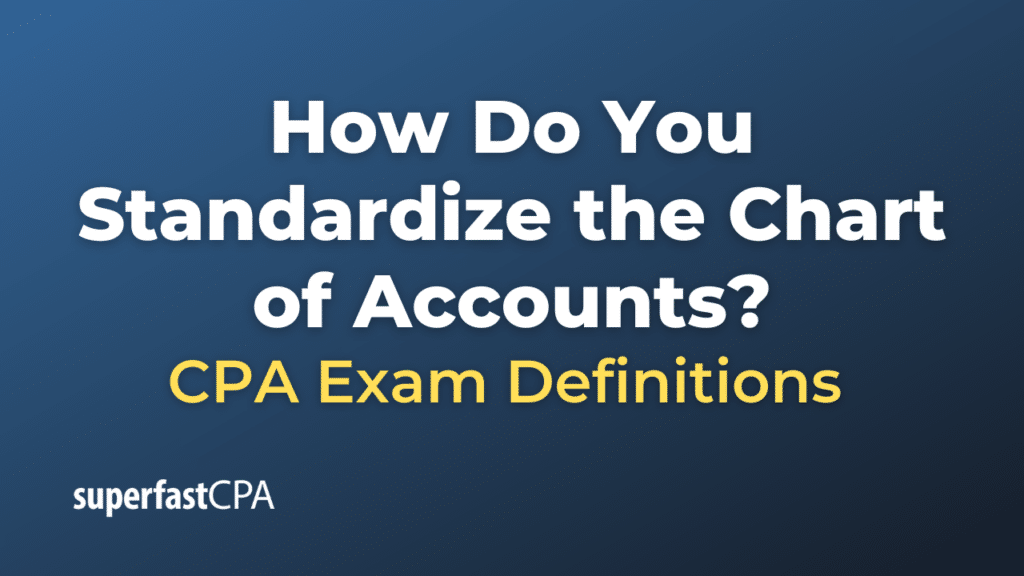Standardize the Chart of Accounts
Standardizing a Chart of Accounts (CoA) involves creating a consistent and logical structure for capturing and reporting financial data. A standardized CoA provides clarity, consistency, and comparability across an organization or even across multiple entities within a larger corporate structure.
Here’s a step-by-step guide on how to standardize the Chart of Accounts:
- Assess the Current Situation:
- Review the existing CoA (if there is one).
- Understand the current needs and shortcomings. Talk to key stakeholders, including those in finance, operations, and management.
- Define the Structure:
- Determine how granular or summarized the CoA needs to be. This is a balance; too detailed can be cumbersome, but too high-level can lack useful specifics.
- Decide on a numbering system. Standard practice is to leave gaps between account numbers to allow for future additions.
- Group accounts by type (e.g., assets, liabilities, equity, revenue, expenses).
- Standardize Account Names:
- Use clear and descriptive names.
- Avoid using names that are too specific or too vague.
- Ensure consistency in naming conventions (e.g., “Accounts Receivable” rather than sometimes using “A/R” or “Receivables”).
- Develop Account Descriptions:
- Create brief descriptions for each account to clarify its purpose and use. This will help ensure that transactions are posted to the appropriate account.
- Use Parent-Child Relationships:
- For larger organizations or those with diverse operations, it can be beneficial to use a parent-child relationship in the CoA. This means main accounts (parents) have sub-accounts (children) for more detailed tracking.
- Consider Segmentations:
- For organizations with multiple departments, locations, or product lines, consider segmenting the CoA. This means using additional codes or segments in account numbers to designate departments, locations, etc. For instance, a company might use the first three digits of an account number for the department and the next four digits for the account type.
- Implement Control Accounts:
- Some accounts, like Accounts Receivable or Inventory, might be control accounts that summarize data from subsidiary ledgers.
- Review Regulatory and Reporting Needs:
- Ensure the CoA structure aligns with regulatory requirements, especially if the company operates in multiple jurisdictions.
- Align with the organization’s reporting needs, considering both internal management reports and external financial statements.
- Roll Out and Training:
- Once the standardized CoA is developed, communicate the changes to all relevant stakeholders.
- Provide training or guidelines to those involved in transaction recording, ensuring they understand the new structure and account uses.
- Review and Update Periodically:
- A CoA should not be static. Periodically review and adjust it to account for changes in the business, industry practices, or regulatory requirements.
- Implement Technology Solutions:
- Consider using accounting software that allows for easy adjustments and tailoring of the CoA. Some platforms also enable reporting by account segments or offer integration with other business systems.
Remember, while standardization is crucial, the CoA should also be flexible enough to evolve with the organization’s changing needs.
Example of How to Standardize the Chart of Accounts
Let’s illustrate this using a fictional company, “TechTonic Innovations,” which produces a range of electronic gadgets.
TechTonic Innovations – Standardizing the Chart of Accounts
Current Situation:
- TechTonic has grown rapidly and expanded into new product lines. They started with just headphones and now produce smartwatches, tablets, and more.
- Their existing CoA is dated, with inconsistent account names and no clear structure.
Standardized Structure:
- Assets:
- 1000s: Current Assets
- 2000s: Fixed Assets
- 3000s: Other Assets
- Liabilities:
- 4000s: Current Liabilities
- 5000s: Long-term Liabilities
- Equity:
- 6000s: Owner’s Equity
- Revenue:
- 7000s: Sales
- 8000s: Other Income
- Expenses:
- 9000s: Operating Expenses
- 10000s: Non-operating Expenses
Standardize Account Names:
Instead of having:
- A/R” becomes “1010 – Accounts Receivable”
- Fixed Asst.” becomes “2010 – Fixed Assets”
Develop Account Descriptions:
- 1010 – Accounts Receivable: Amounts owed to TechTonic from customers for products sold.
Use Parent-Child Relationships:
For Revenue:
- 7010 – Headphone Sales”
- “7020 – Tablet Sales”
- “7030 – Smartwatch Sales”
Consider Segmentations:
If TechTonic has three departments (Production, Sales, and R&D), their CoA for expenses might look like:
- 9010-01 – Production Salaries”
- “9010-02 – Sales Salaries”
- “9010-03 – R&D Salaries”
Control Accounts:
- 1010 – Accounts Receivable” might be a control account, summarizing individual customer balances from a subsidiary sales ledger.
Roll Out and Training: TechTonic organizes a series of training sessions ensuring all financial and non-financial staff understand the new CoA structure.
By following such a structure and process, TechTonic Innovations ensures clarity, accuracy, and efficiency in its financial reporting and internal tracking. This standardization helps them make informed decisions and allows stakeholders to better understand the company’s financial position.













